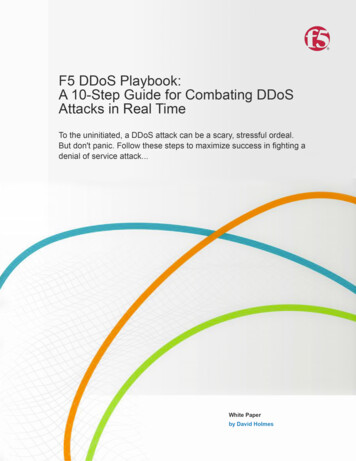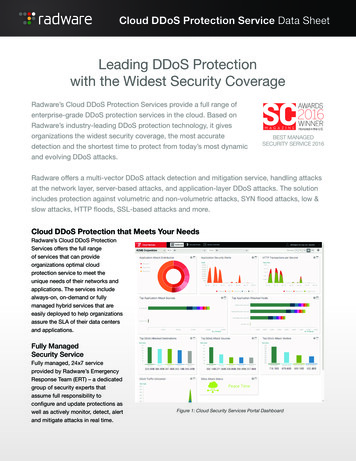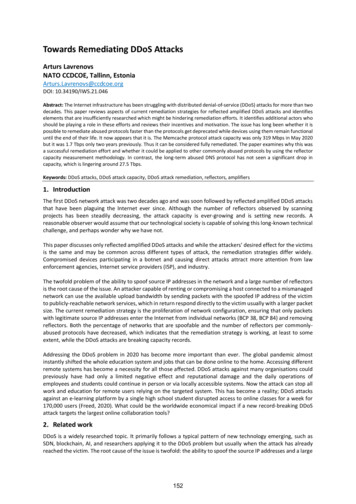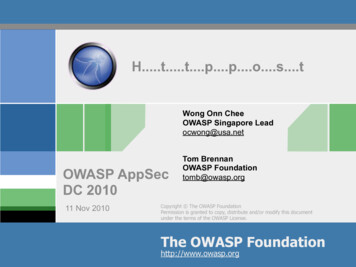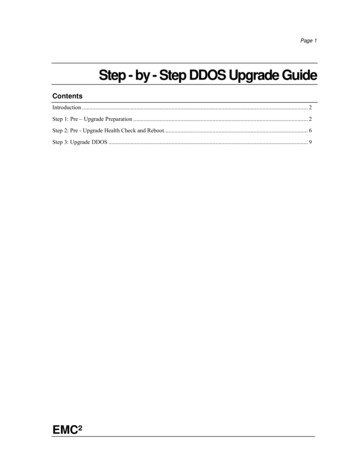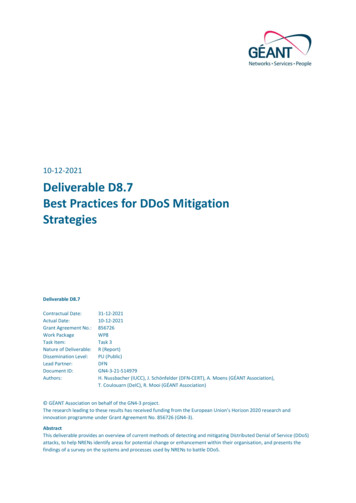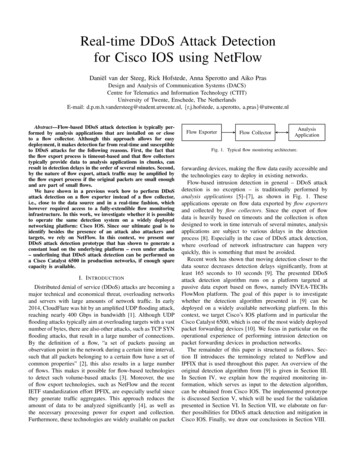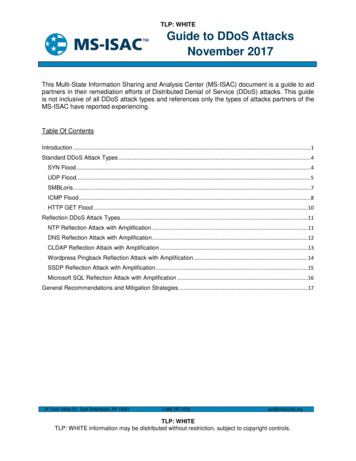
Transcription
TLP: WHITEGuide to DDoS AttacksNovember 2017This Multi-State Information Sharing and Analysis Center (MS-ISAC) document is a guide to aidpartners in their remediation efforts of Distributed Denial of Service (DDoS) attacks. This guideis not inclusive of all DDoS attack types and references only the types of attacks partners of theMS-ISAC have reported experiencing.Table Of ContentsIntroduction .1Standard DDoS Attack Types .4SYN Flood .4UDP Flood.5SMBLoris .7ICMP Flood .8HTTP GET Flood .10Reflection DDoS Attack Types.11NTP Reflection Attack with Amplification .11DNS Reflection Attack with Amplification .12CLDAP Reflection Attack with Amplification .13Wordpress Pingback Reflection Attack with Amplification .14SSDP Reflection Attack with Amplification.15Microsoft SQL Reflection Attack with Amplification .16General Recommendations and Mitigation Strategies .1731 Tech Valley Dr., East Greenbush, NY 120611.866.787.4722soc@cisecurity.orgTLP: WHITETLP: WHITE information may be distributed without restriction, subject to copyright controls.
TLP: WHITEGuide to DDoS AttacksNovember 2017IntroductionA Denial of Service (DoS) attack is an attempt to make a system unavailable to the intendeduser(s), such as preventing access to a website. A successful DoS attack consumes allavailable network or system resources, usually resulting in a slowdown or server crash.Whenever multiple sources are coordinating in the DoS attack, it becomes known as a DDoSattack.MS-ISAC regularly observes two methods of DDoS attacks: Standard and Reflection.A Standard DDoS attack occurs when attackers send a substantial amount of malformednetwork traffic directly to a target server or network. One of the ways an attacker canaccomplish this is by using a botnet to send the traffic. A botnet is a large number of victimcomputers, or zombies, connected over the Internet, that communicate with each other and canbe controlled from a single location. When an attacker uses a botnet to perform the DDoSattack, they send instructions to some or all of the zombie machines connected to that botnet,thereby magnifying the size of their attack, making it originate from multiple networks andpossibly from multiple countries.Figure 1: Example Standard DDoS SYN FloodImage Source: Center for Internet SecurityA Reflection DDoS attack occurs when attackers spoof their IP address to pose as the intendedvictim and then send legitimate requests to legitimate public-facing servers. The responses tothese requests are sent to the intended victim and originate from legitimate servers.In addition to these methods, a technique used by attackers to increase the effectiveness oftheir attack is called Amplification. Usually used in conjunction with Reflection attacks,Amplification occurs when the response that is sent to the victim is larger than the request thatis sent from the attacker. The attacker is able to orchestrate this by requesting a large amount ofdata from a third-party system. As the below drawing illustrates, this might occur when the31 Tech Valley Dr., East Greenbush, NY 120611.866.787.4722soc@cisecurity.orgPage 1 of 17TLP: WHITETLP: WHITE information may be distributed without restriction, subject to copyright controls.
TLP: WHITEGuide to DDoS AttacksNovember 2017attacker spoofs its IP address, pretending to be the victim, and requests all known data from apublic server. This results in the attacker sending a request that is small in size, but results inthe public server responding to the victim with a large amount of data.Figure 2: Example DNS Reflection DDoS with AmplificationImage Source: Center for Internet SecurityIn addition to the use of botnets, some tools are freely available online that cyber threat actorscan use to perform DDoS attacks. Most of these tools were originally designed to be stresstesters and have since become open source tools used to conduct DDoS attacks by amateurcyber threat actors. Popular examples of these tools include the Low Orbit Ion Cannon (LOIC)and the High Orbit Ion Cannon (HOIC). These tools can be downloaded, installed, and utilizedby anyone who wishes to be a part of an ongoing DDoS attack. With the goal of consuming allavailable bandwidth allocated to the target, the LOIC sends significant amounts of TransmissionControl Protocol (TCP) and User Datagram Protocol (UDP) traffic, while the HOIC specificallysends HTTP traffic. Other examples of tools that can be used to perform DDoS activities includeMetasploit, Pyloris, and Slowloris.Figure 3: Image of the LOIC Graphical UserImage Source: en.wikipedia.org31 Tech Valley Dr., East Greenbush, NY 120611.866.787.4722soc@cisecurity.orgPage 2 of 17TLP: WHITETLP: WHITE information may be distributed without restriction, subject to copyright controls.
TLP: WHITEGuide to DDoS AttacksNovember 2017While the main purpose behind a DDoS attack is the malicious consumption of resources,different attackers may use different techniques to generate the traffic necessary for an effectiveDDoS. A lone actor with a botnet at their disposal may use that botnet to orchestrate theattacks. However, botnets are also available for hire, with operators charging minimal fees forshort duration attacks. A group of actors working together may choose to use the same type offree tool, rather than trying to gain access to a botnet. Attacks like these are usually lesssuccessful, as it is difficult to coordinate enough attackers for the effect to be noticeable.31 Tech Valley Dr., East Greenbush, NY 120611.866.787.4722soc@cisecurity.orgPage 3 of 17TLP: WHITETLP: WHITE information may be distributed without restriction, subject to copyright controls.
TLP: WHITEGuide to DDoS AttacksNovember 2017Standard DDoS Attack TypesSYN FloodA SYN Flood is one of the most common forms of DDoS attacks observed by the MS-ISAC. Itoccurs when an attacker sends a succession of TCP Synchronize (SYN) requests to the targetin an attempt to consume enough resources to make the server unavailable for legitimate users.This works because a SYN request opens network communication between a prospective clientand the target server. When the server receives a SYN request, it responds acknowledging therequest and holds the communication open while it waits for the client to acknowledge the openconnection. However, in a successful SYN Flood, the client acknowledgment never arrives, thusconsuming the server’s resources until the connection times out. A large number of incomingSYN requests to the target server exhausts all available server resources and results in asuccessful DDoS attack.Recommendations: To identify a SYN Flood, investigate network logs and locate the TCP SYN flag. Tcpdump orWireshark may work for this purpose.o TCP SYN packets are normal and are not necessarily indicative of malicious activity.Instead look for a large number of SYN packets, from multiple sources, over a shortduration. If you identify an attack, try to leverage your upstream network service provider in order forthem to mitigate the activity before it reaches your network. To help minimize the impact of successful SYN Flood attacks, define strict “TCP keepalive”and “maximum connection” rules on all perimeter devices, such as firewalls and proxyservers. On some firewall appliances, you can enable “SYN cookies” to help mitigate the effects of aSYN Flood. Enabling SYN cookies forces the firewall to validate the TCP connectionbetween client and server before traffic is passed to the server. When attackers never senda final acknowledgment of the open connection, the firewall drops the connection.31 Tech Valley Dr., East Greenbush, NY 120611.866.787.4722soc@cisecurity.orgPage 4 of 17TLP: WHITETLP: WHITE information may be distributed without restriction, subject to copyright controls.
TLP: WHITEGuide to DDoS AttacksNovember 2017Slowloris Attacks: While Slowloris is a DoS tool that can be easily accessed by threat actors,the term Slowloris is also used to describe a type of DoS attack. Slowloris attacks attempt toestablish multiple TCP connections on a target web server, and hold them open for as long aspossible by sending partial requests, very similar to a SYN Flood.Variation of SYN Flood: ESSYN/XSYN FloodAn ESSYN Flood, also known as an XSYN Flood, is an attack designed to target entitiesusing stateful firewalls. The attack works when a large number of unique source IP addressesall attempt to open connections with the target destination IP. Each new connection from aunique source IP creates a new entry in the firewall state table. The purpose of this attack is tocreate more unique connections then there is space for in the firewall’s state table. Once thetable is full, the firewall will not accept any additional inbound connections, denying service tolegitimate users attempting to access the destination IP.Variation of SYN Flood: PSH FloodA Push (PSH) Flood involves sending a large number of TCP packets with the PSH bitenabled. The purpose of a PSH packet is to bypass packet buffering, which allows for theefficient transfer of data by ensuring packets are filled to the maximum segment size whenmultiple packets are sent over a TCP connection. If the PSH bit is enabled, it indicates thepacket should immediately be sent to the application. In normal circumstances, this does notpresent an issue, however when a significant number of PSH packets are sent to a targetserver, there is a potential to overload its resources, creating a DoS situation.31 Tech Valley Dr., East Greenbush, NY 120611.866.787.4722soc@cisecurity.orgPage 5 of 17TLP: WHITETLP: WHITE information may be distributed without restriction, subject to copyright controls.
TLP: WHITEGuide to DDoS AttacksNovember 2017UDP FloodA UDP Flood is very similar to a SYN Flood in that an attacker uses a botnet to send asignificant amount of traffic to the target server. The difference is that this attack is much faster,and rather than attempting to exhaust server resources, it seeks to consume all of the availablebandwidth on the server’s network link, thereby denying access to legitimate users. The attackworks because a server that receives a UDP packet on a network port, such as 50555/UDP,checks for an application that is listening on that port. If nothing is listening on that port, it repliesto the sender of the UDP packet with an Internet Control Message Protocol (ICMP) DestinationUnreachable packet. During an attack, a large number of UDP packets arrive, each with variousdestination ports. This forces the server to process each one, and in most cases, respond toeach one. This type of attack can quickly lead to the consumption of all available bandwidth.Recommendations: To identify a UDP Flood, investigate network logs and look for a large number of inboundUDP packets over irregular network ports coming from a large number of source IPaddresses.o Many legitimate services use UDP for their network traffic. Common UDP ports are 53(DNS), 88 (Kerberos), 137/138/445 (Windows), and 161 (SNMP). When investigating aDDoS attack, look for UDP traffic with high numbered network ports (1024 ). If you identify an attack, try to leverage your upstream network service provider in order forthem to mitigate the activity before it reaches your network. To minimize the effect of UDP Flood attacks, define strict rules on your perimeter networkdevices, like firewalls, to allow only inbound traffic on ports that are required.31 Tech Valley Dr., East Greenbush, NY 120611.866.787.4722soc@cisecurity.orgPage 6 of 17TLP: WHITETLP: WHITE information may be distributed without restriction, subject to copyright controls.
TLP: WHITEGuide to DDoS AttacksNovember 2017SMBLorisA Server Message Block (SMB) SMBLoris attack is an application-level DDoS attack that occurswhen a cyber threat actor opens multiple SMB connections to a device, maliciously consumingmemory with minimal attack cost. SMB is a remote access protocol used for providing sharedaccess to files, printers, and various communications between devices over port 445. Allversions of SMB are vulnerable to SMBLoris, because the vulnerability lies in the way SMBpackets are processed and the memory is allocated. Windows and Samba software devices areboth susceptible to the attack.A connection made with a single IPv4 or IPv6 address impacts up to 8GB of memory if an actorsends the attack over both IPv4 and IPv6, which allows for one computer to cause 16GB ofmemory to be consumed while utilizing only 512 MB of its own memory. Eventually the targetedcomputer cannot allocate any more memory and forces the Windows computer to becomeunresponsive, which results in the computer needing to be manually rebooted. If this attackoccurs against a Linux device with Samba, the device is forced into its configured Out ofMemory (OOM) behavior.Recommendations: To block a remote SMBLoris attack from occurring, configure the border firewall to block allingress traffic over ports 445 and 139. To block an internal SMBLoris attack from occurring, set an artificial rate limit for the numberof connections local devices can have open.31 Tech Valley Dr., East Greenbush, NY 120611.866.787.4722soc@cisecurity.orgPage 7 of 17TLP: WHITETLP: WHITE information may be distributed without restriction, subject to copyright controls.
TLP: WHITEGuide to DDoS AttacksNovember 2017ICMP FloodAn ICMP Flood occurs when an attacker uses a botnet to send a large number of ICMP packetsto a target server in an attempt to consume all available bandwidth and deny legitimate usersaccess. This attack works when a large number of sources can send enough ICMP traffic toconsume all available bandwidth of the target’s network.An example of this could be the “ping” command. This command is primarily used to testnetwork connectivity between two points on a network. However, it is possible to supply thiscommand with different variables to make the ping larger in size and occur more often. By usingthese variables correctly, and with enough source machines initiating the traffic, it is possible toconsume all of the available bandwidth.Recommendations: To identify an ICMP Flood, investigate network logs and look for a significant amount ofinbound ICMP traffic from a large number of sources.o Depending on what tool you are using to investigate your logs, you can identify ICMPpackets either by the protocol displayed in the graphical user interface, such as withWireShark. When analyzing ICMP traffic you will notice that no port information isavailable, as ICMP does not use network ports like TCP or UDP.o If you are using a tool that displays the network protocols as numbered values, ICMP isprotocol 1.o There are also ICMP type and code fields that identify what ICMP traffic is being sent orreceived. For a complete list of these types and codes, please seehttp://www.nthelp.com/icmp.html If you identify an attack, try to leverage your upstream network service provider in order forthem to mitigate the activity before it reaches your network. To mitigate some of the damage of ICMP Flood attacks, block ICMP traffic at perimeternetwork devices such as routers. Additionally, set a packet-per-second threshold for ICMPrequests on perimeter routers. If the amount of inbound ICMP traffic exceeds this threshold,the excess traffic is ignored until the next second. Packet-per-second thresholds effectivelykeep your network from being overrun with ICMP traffic.o Note: The above step does not stop a determined ICMP Flood. If there is enoughinbound traffic to exhaust the bandwidth between the upstream network provider and theperimeter device filtering ICMP, legitimate traffic may be dropped, or delayed to the pointof a DOS. If this is the case, it is necessary to contact the upstream network serviceprovider to have ICMP activity dropped at their level before it reaches your network link.31 Tech Valley Dr., East Greenbush, NY 120611.866.787.4722soc@cisecurity.orgPage 8 of 17TLP: WHITETLP: WHITE information may be distributed without restriction, subject to copyright controls.
TLP: WHITEGuide to DDoS AttacksNovember 2017ICMP Flood Variant Using Reflection: Smurf AttackA Smurf attack is an alternate method of carrying out an ICMP Flood attack. In a Smurfattack, the attacker uses the target’s IP address as their own, which is called spoofing, andthen sends ICMP ping requests to the broadcast IP address of a public network on theInternet. The broadcast IP address of a network will send any traffic that it receives to allother IP addresses within its network. Therefore, when the ICMP ping request is received bythe broadcast IP address, it is then forwarded on to all live computers on its network. Each ofthose computers think that these ping requests are coming from the target IP address andtherefore send their responses to the target rather than back to the attacker. The result ofthis is a large number of unsolicited ICMP ping replies being sent to the target of the DDoS,resulting in the consumption of available bandwidth.31 Tech Valley Dr., East Greenbush, NY 120611.866.787.4722soc@cisecurity.orgPage 9 of 17TLP: WHITETLP: WHITE information may be distributed without restriction, subject to copyright controls.
TLP: WHITEGuide to DDoS AttacksNovember 2017HTTP GET FloodAn HTTP GET Flood occurs when an attacker, or attackers, generate a significant number ofcontinuous HTTP GET requests for a target website in an attempt to consume enoughresources to make the server unavailable for legitimate users. In this case, the attacking IPaddresses never wait for a response from the target server, despite the server attempting torespond to all incoming requests. This results in connections being left open on the web server.A large enough number of incoming HTTP GET requests to the target web server eventuallyexhausts all available server resources and results in a successful DDoS attack.Recommendations: To identify an HTTP GET Flood, investigate network logs and look for a large number ofinbound traffic from a significant number of source IP addresses with a destination port of 80and a protocol of TCP. The packet data should also begin with “GET”. We recommend usingeither Tcpdump or Wireshark.o HTTP GET requests are normal and are not on their own indicative of malicious activity.Look for a large number of identical GET requests coming from a large number ofsources over a short period. The same source IP addresses should re-send the sameGET requests rapidly. If you identify an attack, leverage a DDoS mitigation service provider for the best results inmitigating this activity. It is difficult to set up proactive security measures to block against this attack, as legitimatetraffic is used to carry it out. Often, rate based protections are not sufficient to block thisattack, and the source IP addresses of the attack are part of a large botnet, so blockingevery source IP is not efficient and may include legitimate users.o One solution that may help mitigate this type of attack is to use a Web ApplicationFirewall (WAF). HTTP Floods often exhibit trends that a correctly configured WAF filtersand blocks without blocking legitimate access to the web server.HTTP GET Flood Variation: HTTP POST FloodAnother HTTP Flood incorporates the use of the HTTP POST request instead of GET.This attack works because it forces the web server to allocate more resources inresponse to each inbound request. A large number of these requests could tie up enoughserver resources as to deny legitimate users access to the web server.31 Tech Valley Dr., East Greenbush, NY 120611.866.787.4722soc@cisecurity.orgPage 10 of 17TLP: WHITETLP: WHITE information may be distributed without restriction, subject to copyright controls.
TLP: WHITEGuide to DDoS AttacksNovember 2017Reflection DDoS Attack TypesNTP Reflection Attack with AmplificationA Network Time Protocol (NTP) reflection attack occurs when the attacker uses traffic from alegitimate NTP server to overwhelm the resources of the target. NTP is used to synchronizeclocks on networked machines and runs over port 123/UDP. An obscure command, monlist,allows a requesting computer to receive information regarding the last 600 connections to theNTP server. An attacker can spoof the target’s IP address and send a monlist command torequest that the NTP server send a large amount of information to the target. These responsestypically have a fixed packet size that can be identified across a large number of replies. Sincethe response from the NTP server is larger than the request sent from the attacker, the effect ofthe attack is amplified. When an attacker spoofs the target’s IP address and then sends themonlist command to a large number of Internet-facing NTP servers, the amplified responses aresent back to the target. This eventually results in the consumption of all available bandwidth.Recommendations: To identify a NTP Reflection Attack with Amplification, investigate your network logs andlook for inbound traffic with a source port of 123/UDP and a specific packet size. Once identified, try to leverage your upstream network service provider and provide themwith the attacking IP addresses and the packet sizes used in the attack. Upstream providershave the ability to place a filter at their level that forces inbound NTP traffic, using thespecific packet size that you are experiencing, to drop. Along with remediating inbound attacks, take the following preventative measures to ensurethat your NTP servers are not used to attack others.o If you are unsure whether or not your NTP server is vulnerable to being utilized in anattack, follow the instructions available at OpenNTP: hxxp://openntpproject.org/.o Upgrade NTP servers to version 2.4.7 or later, which removes the monlist commandentirely, or implement a version of NTP that does not utilize the monlist command, suchas OpenNTPD.o If you are unable to upgrade your server, disable the monlist query feature by adding“disable monitor” to your ntp.conf file and restarting the NTP process.o Implement firewall rules that restrict unauthorized traffic to the NTP server.31 Tech Valley Dr., East Greenbush, NY 120611.866.787.4722soc@cisecurity.orgPage 11 of 17TLP: WHITETLP: WHITE information may be distributed without restriction, subject to copyright controls.
TLP: WHITEGuide to DDoS AttacksNovember 2017DNS Reflection Attack with AmplificationA Domain Name System (DNS) Reflection attack occurs when the attacker manipulates theDNS system to send an overwhelming amount of traffic to the target. DNS servers resolve IPaddresses to domain names allowing the average Internet user to type an easily remembereddomain name into their Internet browser, rather than remembering the IP addresses ofwebsites. A DNS Reflection attack occurs when an attacker spoofs the victim’s IP address andsends DNS name lookup requests to public DNS servers. The DNS server then sends theresponse to the target server, and the size of the response depends on the options specified bythe attacker in their name lookup request. To get the maximum amplification, the attacker canuse the word “ANY” in their request, which returns all known information about a DNS zone to asingle request. When an attacker spoofs a target’s IP address and sends DNS lookup requeststo a large number of public DNS servers, the amplified responses are sent back to the targetand will eventually result in the consumption of all available bandwidth.Recommendations: To identify if a DNS Reflection Attack with Amplification is occurring, investigate networklogs and look for inbound DNS query responses with no matching DNS query requests.o DNS queries are normal and are themselves not indicative of an attack. If you identify an attack, try to leverage your upstream network service provider in order forthem to mitigate the activity before it reaches your network. Along with remediating inbound attacks, disable DNS recursion, if possible, by following theguidelines provided by your DNS server vendor (BIND, Microsoft, etc.). In doing so, thisensures that your DNS servers are not used to attack others.o Instructions for disabling recursion can also be found at Team Cymru: ctions.html.o To discover if any of your public DNS servers may be used to attack others, use the freetest at openresolverproject.org.31 Tech Valley Dr., East Greenbush, NY 120611.866.787.4722soc@cisecurity.orgPage 12 of 17TLP: WHITETLP: WHITE information may be distributed without restriction, subject to copyright controls.
TLP: WHITEGuide to DDoS AttacksNovember 2017CLDAP Reflection Attack with AmplificationA Connection-less Lightweight Directory Access Protocol (CLDAP) Reflection Attack withAmplification occurs when an attacker sends a CLDAP request to an LDAP server, using aspoofed sender IP address. CLDAP is used to connect, search, and modify shared Internetdirectories. It runs over port 389/UDP.A CLDAP Reflection attack occurs when a cyber threat actor spoofs the victim’s IP address andsends a CLDAP query to multiple LDAP servers. The LDAP servers then send the requesteddata to the spoofed IP address. This unsolicited response is what results in a DDoS attack, asthe victim's machine can't process an overabundance of LDAP/CLDAP data at the same time.The amplification is due to the number of times a packetis enlarged while processed by the LDAP server. LDAPUDP protocol responses are much larger than the initialrequest with an amplification factor of 52, and can peakat up to a factor of 70.TCP LDAP Reflection Attack withAmplification VariantThe LDAP Reflection Attack withAmplification variant can be used overport 389/TCP. This attack has anamplification factor of 46, and canpeak at up to a factor of 55.Recommendations: To identify a CLDAP Reflection Attack with Amplification, investigate your network logs andlook for inbound traffic with a source port of 389/UDP. Once identified, try to leverage your upstream network service provider and provide themwith the attacking IP addresses and the packet sizes used in the attack. Upstream providershave the ability to place a filter at their level. Create a DDoS protection plan. Along with remediating inbound attacks, take the following preventative measures to ensurethat your servers are not used to attack others.o Implement ingress firewall rules that restrict unauthorized use of the LDAP server. Auditing policies can be used to provide reporting of network services that are potentiallyexploitable as reflection attacks.31 Tech Valley Dr., East Greenbush, NY 120611.866.787.4722soc@cisecurity.orgPage 13 of 17TLP: WHITETLP: WHITE information may be distributed without restriction, subject to copyright controls.
TLP: WHITEGuide to DDoS AttacksNovember 2017Wordpress Pingback Reflection Attack with AmplificationWordPress is a popular Content Management System (CMS) that is used to develop andmaintain websites and blogs. A function of WordPress sites is called the Pingback feature,which is used to notify other WordPress websites that you have put a link to their website onyour site. Sites using WordPress automate this process, and maintain automated lists linkingback to sites that link to them. These “pingbacks” are sent as Hypertext Transfer Protocol(HTTP) POST requests to the /xmlrpc.php page, which is used by WordPress to carry out thepingback process. By default, this feature downloads the entire web page that contains the linkthat triggered the pingback process. An attacker can locate any number of WordPress websitesand then send pingback requests to each of them with the URL of the target website, resultingin each of those WordPress websites sending requests to the target server requesting thedownload of the web page. A large number of requests to download the web page caneventually overload the target web server.Recommendations: To identify a WordPress Pingback Reflection attack with Amplification, investigate yournetwork logs and look for a large number of inbound TCP traffic over port 80 from a largenumber of sources. The traffic appears as HTTP GET requests for
The attack works when a large number of unique source IP addresses all attempt to open connections with the target destination IP. Each new connection from a unique source IP creates a new entry in the firewall state table. The purpose of this attack is to create more unique connections then there is space for in the firewall's state table.
